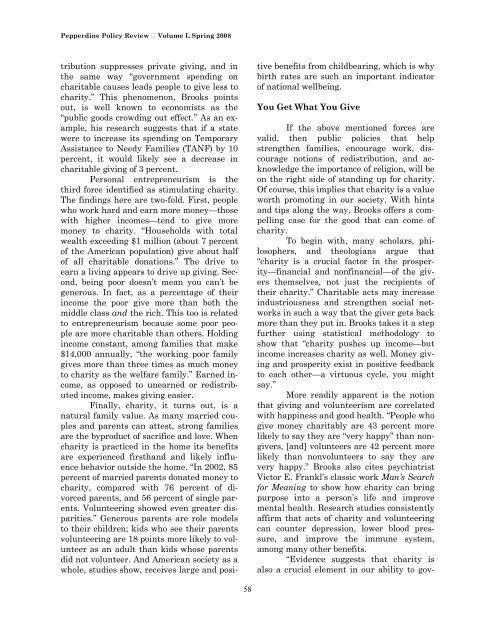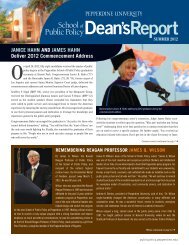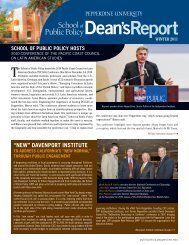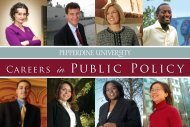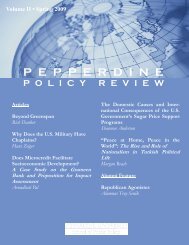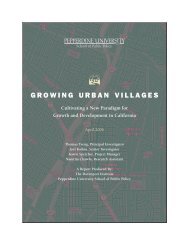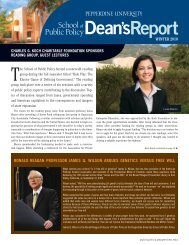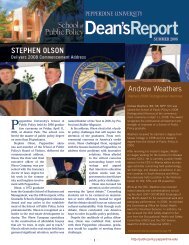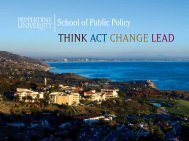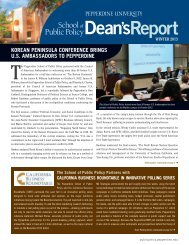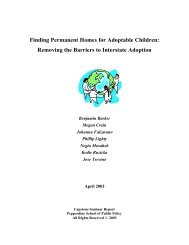Pepperdine University School of Public Policy
Pepperdine University School of Public Policy
Pepperdine University School of Public Policy
Create successful ePaper yourself
Turn your PDF publications into a flip-book with our unique Google optimized e-Paper software.
<strong>Pepperdine</strong> <strong>Policy</strong> Review Volume I, Spring 2008<br />
tribution suppresses private giving, and in<br />
the same way “government spending on<br />
charitable causes leads people to give less to<br />
charity.” This phenomenon, Brooks points<br />
out, is well known to economists as the<br />
“public goods crowding out effect.” As an example,<br />
his research suggests that if a state<br />
were to increase its spending on Temporary<br />
Assistance to Needy Families (TANF) by 10<br />
percent, it would likely see a decrease in<br />
charitable giving <strong>of</strong> 3 percent.<br />
Personal entrepreneurism is the<br />
third force identified as stimulating charity.<br />
The findings here are two-fold. First, people<br />
who work hard and earn more money—those<br />
with higher incomes—tend to give more<br />
money to charity. “Households with total<br />
wealth exceeding $1 million (about 7 percent<br />
<strong>of</strong> the American population) give about half<br />
<strong>of</strong> all charitable donations.” The drive to<br />
earn a living appears to drive up giving. Second,<br />
being poor doesn’t mean you can’t be<br />
generous. In fact, as a percentage <strong>of</strong> their<br />
income the poor give more than both the<br />
middle class and the rich. This too is related<br />
to entrepreneurism because some poor people<br />
are more charitable than others. Holding<br />
income constant, among families that make<br />
$14,000 annually, “the working poor family<br />
gives more than three times as much money<br />
to charity as the welfare family.” Earned income,<br />
as opposed to unearned or redistributed<br />
income, makes giving easier.<br />
Finally, charity, it turns out, is a<br />
natural family value. As many married couples<br />
and parents can attest, strong families<br />
are the byproduct <strong>of</strong> sacrifice and love. When<br />
charity is practiced in the home its benefits<br />
are experienced firsthand and likely influence<br />
behavior outside the home. “In 2002, 85<br />
percent <strong>of</strong> married parents donated money to<br />
charity, compared with 76 percent <strong>of</strong> divorced<br />
parents, and 56 percent <strong>of</strong> single parents.<br />
Volunteering showed even greater disparities.”<br />
Generous parents are role models<br />
to their children; kids who see their parents<br />
volunteering are 18 points more likely to volunteer<br />
as an adult than kids whose parents<br />
did not volunteer. And American society as a<br />
whole, studies show, receives large and positive<br />
benefits from childbearing, which is why<br />
birth rates are such an important indicator<br />
<strong>of</strong> national wellbeing.<br />
You Get What You Give<br />
If the above mentioned forces are<br />
valid, then public policies that help<br />
strengthen families, encourage work, discourage<br />
notions <strong>of</strong> redistribution, and acknowledge<br />
the importance <strong>of</strong> religion, will be<br />
on the right side <strong>of</strong> standing up for charity.<br />
Of course, this implies that charity is a value<br />
worth promoting in our society. With hints<br />
and tips along the way, Brooks <strong>of</strong>fers a compelling<br />
case for the good that can come <strong>of</strong><br />
charity.<br />
To begin with, many scholars, philosophers,<br />
and theologians argue that<br />
“charity is a crucial factor in the prosperity—financial<br />
and nonfinancial—<strong>of</strong> the givers<br />
themselves, not just the recipients <strong>of</strong><br />
their charity.” Charitable acts may increase<br />
industriousness and strengthen social networks<br />
in such a way that the giver gets back<br />
more than they put in. Brooks takes it a step<br />
further using statistical methodology to<br />
show that “charity pushes up income—but<br />
income increases charity as well. Money giving<br />
and prosperity exist in positive feedback<br />
to each other—a virtuous cycle, you might<br />
say.”<br />
More readily apparent is the notion<br />
that giving and volunteerism are correlated<br />
with happiness and good health. “People who<br />
give money charitably are 43 percent more<br />
likely to say they are “very happy” than nongivers,<br />
[and] volunteers are 42 percent more<br />
likely than nonvolunteers to say they are<br />
very happy.” Brooks also cites psychiatrist<br />
Victor E. Frankl’s classic work Man’s Search<br />
for Meaning to show how charity can bring<br />
purpose into a person’s life and improve<br />
mental health. Research studies consistently<br />
affirm that acts <strong>of</strong> charity and volunteering<br />
can counter depression, lower blood pressure,<br />
and improve the immune system,<br />
among many other benefits.<br />
“Evidence suggests that charity is<br />
also a crucial element in our ability to gov-<br />
58


